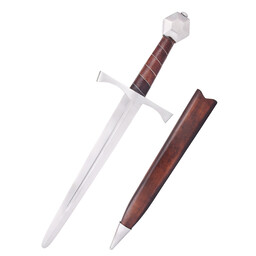Product description
This type of short dagger was very popular during the Middle Ages, both with knights, as secondary weapon, and with common soldiers, pikemen and archers. This model was used during the 14th and 15th century. The dagger has a blade of tempered spring steel and is blunt. It is suitable for light sword fighting. The dagger is delivered including scabbard.
Details:
Blade: EN45 spring steel, oil-tempered
Length: ca. 44,5 cm
Blade length: ca. 29,0 cm
Blade width: max. 31 mm
Edge: blunt
Rockwell hardness: ca. 48 HRC
Weight (ex. scabbard): ca. 540 g
Including scabbard
Based on a historical original
Transport weight (gram): 3000 *
We do not sell this product to customers under the age of 18. Click here for more information on the European arms acts.
This item is produced in limited quantities only. This means that every piece is unique. Sizes & finish may vary lightly from piece to piece.
Prevent rust and corrosion by oiling your weapons regularly. Remove rust easily with black sandpaper. Remove burrs with a whetstone. Make sure you have removed all burrs before using a battle-ready weapon, as they can cause wounds.
Tip: How to adjust the finish of your armour and weaponry
Luxurious (polished)- polish the steel with metal polish or toothpaste. You can even give the item a mirror-like polish. Test on a small surface first!
Handmade (matte)- soak the steel in cola for 40 minutes to 20 hours. Check regularly and treat with black sandpaper.
Antique (patinated) leave the steel to rust for some time in a damp environment, preferably outside. Remove the red layer of rust, to reveal the corroded top layer.
Please note. After finishing the product yourself, the warranty and return right expire. Celtic WebMerchant is not responsible for the obtained result.
Packaged with 100% recycled material
When packaging this item, we exclusively use 100% recycled plastic and recycled paper/cardboard from FSC certified forests. We reuse a large part of the material directly without the intervention of a recycling process.
Recycle the material by separating your waste:
1. Cardboard: separate or reuse your paper.
2. Plastic cushions, clothing bags and plastic tape: separate or reuse your plastic. If possible, pierce the cushions with a volume reduction needle.
3. Paper packaging for jewelry and small items: these have a plastic inner layer. Remove these, then separate your paper and plastic.












